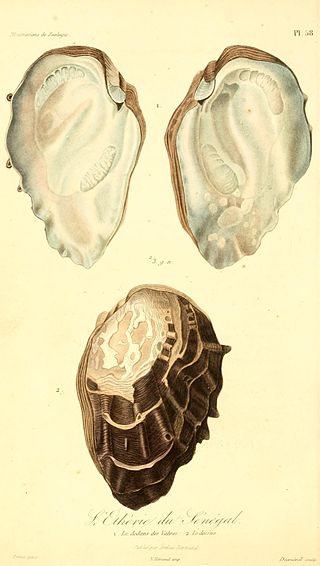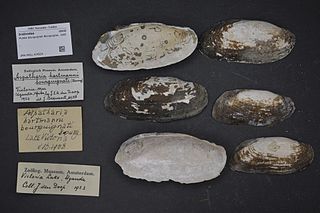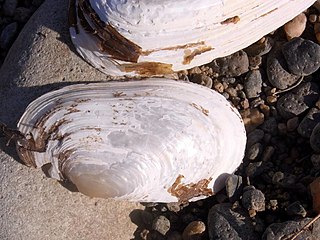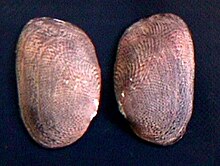
The Percidae are a family of ray-finned fish, part of the order Perciformes, which are found in fresh and brackish waters of the Northern Hemisphere. The majority are Nearctic, but there are also Palearctic species. The family contains more than 200 species in 11 genera. The perches and their relatives are in this family; well-known species include the walleye, sauger, ruffe, and three species of perch. However, small fish known as darters are also a part of this family.

Bivalvia or bivalves, in previous centuries referred to as the Lamellibranchiata and Pelecypoda, is a class of aquatic molluscs that have laterally compressed soft bodies enclosed by a calcified exoskeleton consisting of a hinged pair of half-shells known as valves. As a group, bivalves have no head and lack some typical molluscan organs such as the radula and the odontophore. Their gills have evolved into ctenidia, specialised organs for feeding and breathing.
The Dreissenidae are a family of small freshwater aquatic bivalve molluscs, commonly called mussels although not at all closely related to true mussels. The shells of these bivalves are shaped somewhat like those of true mussels, which they also resemble in attaching themselves to a hard substrate such as stone using a byssus; however, this group is more closely related to the venus clams (Veneridae).

The Unionidae are a family of freshwater mussels, the largest in the order Unionida, the bivalve molluscs sometimes known as river mussels, or simply as unionids.

Hydrometridae is a family of semiaquatic insects, known as marsh treaders or water measurers. They have a characteristic elongated head and body which makes them resemble a yardstick for measuring the water surface.

Margaritiferidae is a family of medium-sized freshwater mussels, aquatic bivalve molluscs in the order Unionida. It is the most threatened of all unionid families.

Unionida is a monophyletic order of freshwater mussels, aquatic bivalve molluscs. The order includes most of the larger freshwater mussels, including the freshwater pearl mussels. The most common families are the Unionidae and the Margaritiferidae. All have in common a larval stage that is temporarily parasitic on fish, nacreous shells, high in organic matter, that may crack upon drying out, and siphons too short to permit the animal to live deeply buried in sediment.
Freshwater bivalves are molluscs of the order Bivalvia that inhabit freshwater ecosystems. They are one of the two main groups of freshwater molluscs, along with freshwater snails.

Etheriidae is a small family of medium-sized freshwater mussels, aquatic bivalve molluscs in the order Unionida. It contains two monotypic genera.

Iridinidae is a family of medium-sized freshwater mussels, aquatic bivalve mollusks in the order Unionida.

Velesunio ambiguus, the floodplain mussel, or the billabong mussel, is a species of freshwater bivalve in the family Hyriidae.

The Mycetopodidae are a family of freshwater pearly mussels in the order Unionida restricted to South America. They are named for the mushroom-like shape of their foot. Like all members of the Unionida they reproduce via a larval stage that temporarily parasitizes fish. Banarescu lists four subfamilies with ten genera in total.

Alathyria profuga is a species of freshwater river mussel, a bivalve mollusk in the family Hyriidae. This species occurs in coastal rivers in eastern New South Wales, Australia. The type specimen was collected from the Hunter River.

Limnoperna fortunei, the golden mussel, is a medium-sized freshwater bivalve mollusc of the family Mytilidae. The native range of the species is China, but it has accidentally been introduced to South America and several Asian countries where it has become an invasive species. It is considered to be an ecosystem engineer because it alters the nature of the water and the bottom habitats of lakes and rivers and modifies the associated invertebrate communities. It also has strong effects on the properties of the water column, modifying nutrient proportions and concentrations, increasing water transparency, decreasing phytoplankton and zooplankton densities, on which it feeds, and enhancing the growth of aquatic macrophytes. Because mussels attach to hard substrata, including the components of industrial, water-treatment and power plants, they have become a major biofouling problem in the areas invaded.

Velesunio is a genus of medium to large sized mussels in the family Hyriidae.

Velesunio wilsonii is a species of freshwater mussel endemic to Australia and comes from the Hyriidae family. Velesunio wilsonii mussels have a thick, dark shell that are sometimes flaky and mostly closed. Velesunio wilsonii have a fleshy foot that sometimes extends outside of the valves. The shell of the Velesunio wilsonii varies from oblong to a symmetrical circle. Velesunio wilsonii size ranges from 40 mm to 120 mm.

The Luciopercinae is a subfamily of ray-finned fish, classified within the family Percidae, the subfamily includes the pike-perches and zingels. The pike-perches of the genus Sander have an Holarctic distribution while the zingels of the tribe Romanichthyini are found in Europe. They are largely freshwater species but some can be found in brackish water.

Romanichthyini is a tribe of freshwater ray-finned fish which is one of two tribes in the subfamily Luciopercinae, which in turn is classified under the family Percidae, the family also includes the perches, pikeperches, ruffes and darters.
Alathyria condola is a species of freshwater river mussel, a bivalve mollusk in the family Hyriidae. This species occurs in coastal rivers in eastern New South Wales, Australia. The type specimen was collected from the Murrumbidgee River.

Echyridella onekaka is a species of freshwater mussel endemic to New Zealand. E. onekaka is an aquatic bivalve mollusc in the family Unionidae, the river mussels.


















